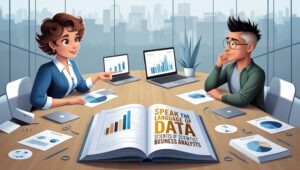In the rapidly evolving world of data-driven decision-making, business analysts often find themselves collaborating with data scientists. While the two roles complement each other, their objectives and terminologies can sometimes seem worlds apart. As a business analyst, learning to “speak the language” of data scientists can significantly enhance collaboration, streamline processes, and ensure project success.
1️⃣ Why Understanding Data Scientists’ Language Matters
- Bridge the Gap: Data scientists focus on technical data manipulation, while business analysts translate insights into actionable strategies. Effective communication ensures alignment.
- Improve Efficiency: Miscommunication can lead to delays, rework, or misunderstood requirements. A shared language minimizes these risks.
- Enhance Credibility: Demonstrating an understanding of key data concepts builds trust and fosters stronger professional relationships.
2️⃣ Key Concepts Every Business Analyst Should Know
- Data Basics: Understand terms like structured vs. unstructured data, data pipelines, and databases.
- Statistical Foundations: Familiarize yourself with concepts like correlation, regression, and probability.
- Machine Learning 101: Learn about supervised and unsupervised learning, model training, and overfitting.
- Data Visualization: Know tools and best practices for presenting data clearly and effectively
3️⃣ Practical Tips to Speak the Language
- Ask Better Questions: Instead of “Can we get a report?”, specify, “Can we generate a predictive model using customer churn data?”
- Clarify Expectations: Ensure both sides agree on metrics, deliverables, and formats for data presentations.
- Leverage Tools Together: Collaborate on tools like Tableau, Python outputs, or Power BI to bridge understanding.
4️⃣ The Mutual Benefits of Collaboration
- For Business Analysts: Gain deeper insights into what data can achieve, enabling better decision-making.
- For Data Scientists: Receive clear business contexts and objectives, allowing for more targeted data analysis.
5️⃣ Learning to Speak Data: Next Steps
- Invest in Knowledge: Take beginner courses in data science basics.
- Collaborate and Observe: Spend time with data scientists to understand their workflows.
- Join Communities: Engage with data and analytics groups to stay updated on trends.
Conclusion
Speaking the language of data scientists isn’t about becoming one; it’s about building a shared understanding to drive successful outcomes. By bridging this gap, business analysts can unlock the full potential of data science projects, delivering solutions that are not only innovative but also aligned with business goals.
Ready to start the conversation? Let’s make data-driven collaboration the norm!







